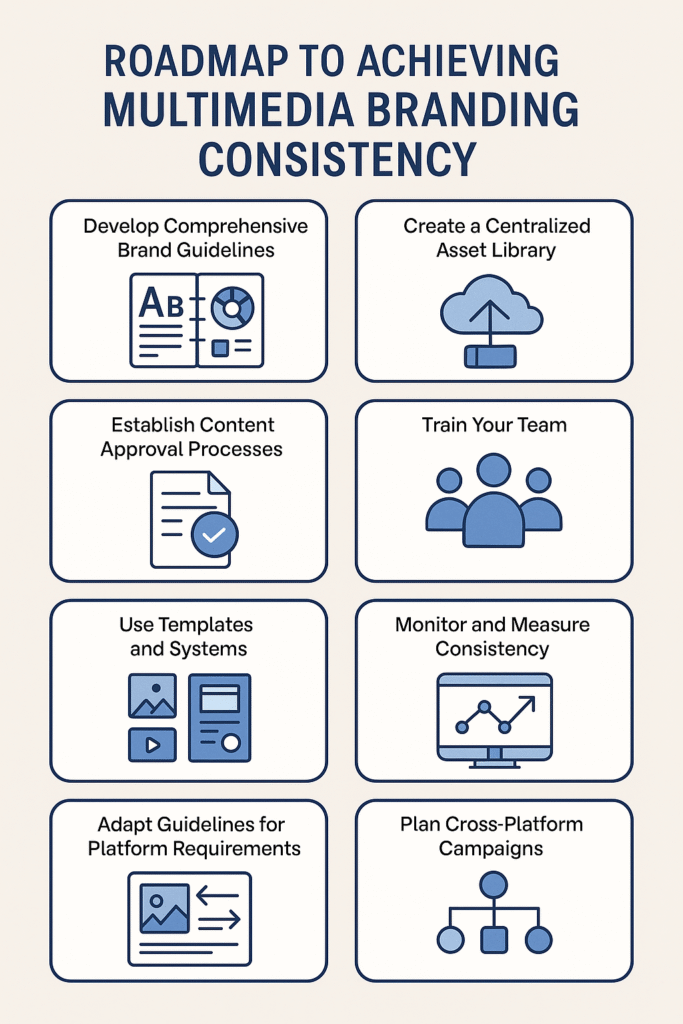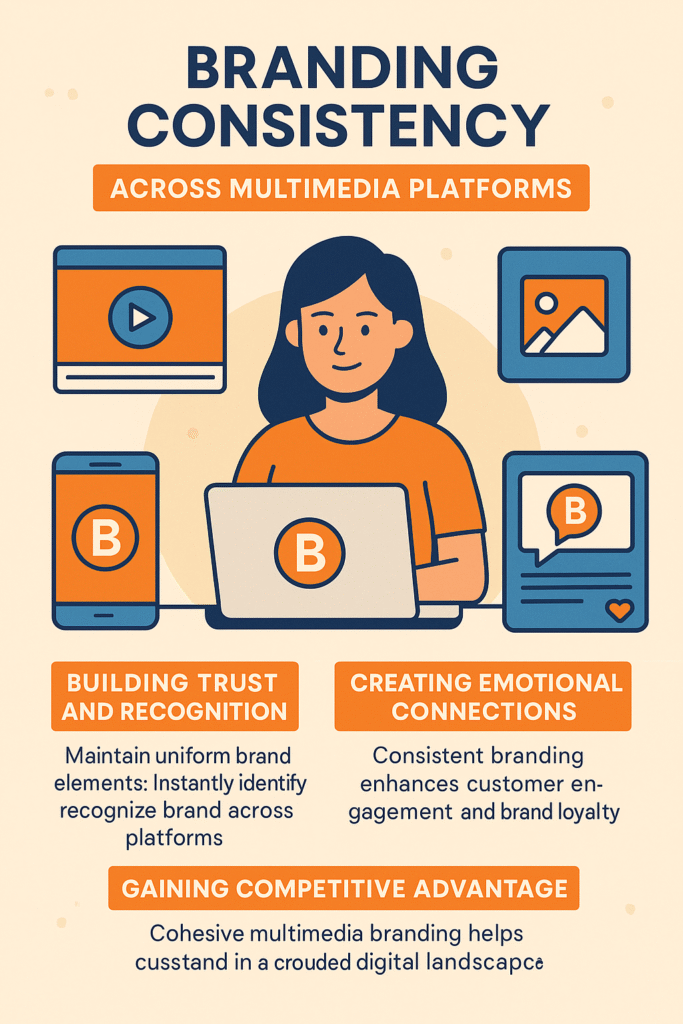Picture this: You scroll through social media and instantly recognise a brand without even seeing their logo. That’s the power of branding consistency in action.
In today’s digital world, customers interact with brands across multiple platforms and formats. Without consistent multimedia branding, you risk confusing your audience and weakening your brand’s impact. Studies show that consistent branding can increase revenue by up to 23%.
This comprehensive guide explores how branding consistency across multimedia platforms can transform your marketing efforts and drive meaningful results for your business.
Table of Contents
What is Multimedia Branding Consistency?
Multimedia branding consistency refers to maintaining uniform brand elements across all digital and traditional media formats. This includes videos, audio content, images, interactive media, and social posts.
Think of it as your brand’s signature style that remains recognisable on TikTok, LinkedIn, or billboards. It encompasses visual elements, audio identity, messaging, and content strategy alignment.
Visual Elements: Your logo, colours, typography, and design style should remain consistent across all content. Apple demonstrates this perfectly with their clean aesthetic across video ads, podcasts, and websites.
Audio Identity: This includes your brand’s voice tone, music style, and sound effects. McDonald’s “I’m Lovin’ It” jingle maintains the same upbeat tone across TV, radio, and social media.
Messaging and Tone: Your brand personality and communication style should shine through consistently. Whether creating formal presentations or casual Instagram reels, your core message should remain recognisable.
Content Strategy Alignment: All multimedia content should support your overall brand strategy. Your YouTube videos should complement email campaigns and align with your social media presence.
Why is it Important?
Branding consistency isn’t just about looking professional – it’s a fundamental business strategy that directly impacts your bottom line. Here’s why multimedia branding consistency should be your top priority.
Building Trust and Recognition: Consistent brand experiences across platforms help customers develop trust and familiarity. Research from Lucidpress shows that consistent branding can increase revenue by 10-20%, highlighting the financial impact.
Creating Emotional Connections: Consistent branding helps create emotional bonds with your audience. When people know what to expect from your brand, they feel more comfortable engaging and making purchases.
Reducing Marketing Costs: A consistent brand strategy reduces time and money spent creating new content from scratch. Established guidelines help teams work efficiently and repurpose content across platforms.
Enhancing Customer Experience: Consistent multimedia branding fosters seamless customer journeys. Whether someone discovers your brand through podcasts or YouTube, they should have a consistent and positive experience.
Gaining Competitive Advantage: In crowded markets, consistent branding helps you stand out from competitors. When audiences instantly recognise your content in feeds, you’ve achieved a significant competitive edge.
Enhancing Brand Recall: Consistent visual and audio elements make your brand more memorable. This improved recall leads to higher conversion rates and stronger customer loyalty over time.
Examples of Consistent Brands
Learning from successful brands provides valuable insights into effective multimedia branding consistency. These companies have mastered maintaining brand identity across various platforms and formats.
Nike’s “Just Do It” Philosophy: Nike demonstrates exceptional consistency by maintaining motivational, achievement-focused messaging across all platforms. Whether on Instagram, TV commercials, or podcast sponsorships, they emphasise pushing limits and achieving greatness. Their bold typography and inspirational storytelling create unmistakable brand experiences.
Coca-Cola’s Happiness Campaign: Coca-Cola maintains consistent branding by focusing on happiness, sharing, and positive emotions. Their red and white colours, distinctive logo, and upbeat messaging remain constant across Super Bowl commercials, social media, and Spotify playlists.
McDonald’s Global Recognition: McDonald’s golden arches and “I’m Lovin’ It” campaign demonstrate how consistency works across cultures and platforms. Their red and yellow colours, friendly tone, and family-focused messaging create identical experiences across local TV, international campaigns, and mobile apps.
Apple’s Minimalist Approach: Apple’s clean, minimalist design philosophy translates seamlessly across all multimedia content. From product videos to podcast ads to websites, they maintain consistent white space, simple typography, and product focus.
Spotify’s Data-Driven Personality: Spotify has created a distinctive brand voice combining data insights with playful humour. Their consistent green branding, data visualisation, and witty copy create recognisable experiences across video ads, social campaigns, and in-app messaging.
How Can We Achieve It?

Achieving multimedia branding consistency requires strategic planning, clear guidelines, and systematic implementation across all marketing channels. Here’s a practical roadmap to build and maintain consistent branding across platforms.
- Develop Comprehensive Brand Guidelines: Create detailed brand guidelines covering every aspect of your multimedia presence. Include logo usage, colour codes, typography, tone of voice, and content style preferences. According to branding experts at 99designs, companies with comprehensive guidelines are 3.5 times more likely to experience strong brand visibility.
- Create a Centralised Asset Library: Build a digital repository where team members can access approved brand assets. Include high-resolution logos, colour palettes, fonts, templates, video clips, and audio files. Tools like Brandfolder or Google Drive help organise these resources effectively.
- Establish Content Approval Processes: Implement a review system where all multimedia content gets approved before publication. This process should involve stakeholders who understand brand guidelines and can ensure consistency across formats.
- Train Your Team: Educate everyone involved in content creation about brand guidelines and consistency importance. This includes designers, copywriters, video editors, social media managers, and external agencies or freelancers.
- Use Templates and Systems: Develop templates for common content types like social posts, video thumbnails, and email headers. These templates ensure visual consistency while allowing creative flexibility within established parameters.
- Monitor and Measure Consistency: Regularly audit multimedia content across all platforms to identify inconsistencies. Use Google Analytics, social media insights, and brand monitoring software to track consistency impact on engagement.
- Adapt Guidelines for Platform Requirements: Whilst maintaining core brand elements, adapt guidelines for different platform specifications. Instagram Stories require different dimensions than YouTube thumbnails, but both should maintain visual identity.
- Plan Cross-Platform Campaigns: When planning multimedia campaigns, consider how content appears across platforms simultaneously. Ensure video ads complement social posts, email campaigns, and website content for cohesive experiences.
How does it Benefit Branding?
The benefits of maintaining multimedia branding consistency extend far beyond aesthetic appeal. They create tangible business value that impacts every aspect of marketing efforts and overall success.
Increased Brand Recognition and Recall: Consistent multimedia branding dramatically improves brand recognition across all touchpoints. When customers encounter content on different platforms, they immediately recognise your brand without a prominent logo display. This recognition translates into higher engagement rates and more effective campaigns.
Enhanced Customer Trust and Loyalty: Consistency builds trust by creating predictable, reliable brand experiences. When customers know what to expect across multimedia channels, they develop stronger emotional connections. Research shows loyal customers are five times more cost-effective than acquiring new ones.
Improved Marketing ROI: Multimedia branding consistency reduces marketing costs whilst improving effectiveness. Established guidelines and templates help teams create content more efficiently, reducing production time and costs. Consistent branding also improves campaign performance and return on investment.
Stronger Market Positioning: Consistent branding helps establish and maintain marketplace position. When multimedia content consistently communicates unique value propositions, customers better understand competitive advantages. This clear positioning makes brand selection easier for customers.
Streamlined Content Creation Process: Brand consistency guidelines streamline content creation workflows. Instead of starting from scratch, teams work within established parameters, leading to faster production and more cohesive campaigns.
Better Employee Alignment: Clear, consistently applied brand guidelines help employees understand company values and mission. This alignment improves internal communication and ensures consistent brand representation across all roles.
Increased Brand Value: Consistent branding contributes to overall brand equity and business valuation. Companies with strong, consistent brands typically command higher prices and enjoy greater investor confidence.
Enhanced Customer Experience: Multimedia branding consistency creates seamless customer journeys across touchpoints. Whether customers interact through social media, email, video, or in-person experiences, consistent branding ensures identical high-quality experiences.
Conclusion
Multimedia branding consistency isn’t just a nice-to-have feature – it’s a business necessity in today’s interconnected digital landscape. As explored throughout this guide, maintaining consistent branding across platforms creates significant benefits, including increased recognition, enhanced trust, improved ROI, and stronger customer relationships.
The brands that succeed in today’s competitive marketplace understand the power of consistency and implement it systematically across every touchpoint. From Nike’s motivational messaging to Apple’s minimalist design philosophy, successful companies demonstrate that consistent multimedia branding creates lasting impressions and drives measurable business results.
Remember that achieving branding consistency requires ongoing commitment and attention to detail. Start by developing comprehensive brand guidelines, creating centralised asset libraries, establishing approval processes, and regularly monitoring content across all platforms.
Take action now by auditing your current multimedia content and identifying areas where you can improve consistency. Your brand’s success depends on the cohesive experience you create for customers across every platform and format they encounter.
FAQs
What is the difference between branding consistency and brand identity?
Brand identity refers to the visual and conceptual elements that make up your brand, such as logos, colours, and messaging. Branding consistency is the practice of maintaining these identity elements uniformly across all multimedia platforms and touchpoints.
How often should I update my multimedia branding guidelines?
Review your branding guidelines annually or whenever you launch major campaigns, rebrand, or expand to new platforms. However, avoid frequent changes as consistency requires stability over time.
Can small businesses achieve multimedia branding consistency on limited budgets?
Yes, small businesses can achieve consistency by focusing on core elements like logo usage, colour palette, and tone of voice. Free tools like Canva and Google Workspace can help maintain consistency without significant investment.
What’s the biggest mistake companies make with multimedia branding?
The most common mistake is creating platform-specific content without considering overall brand consistency. Each platform may have different requirements, but core brand elements should remain consistent across all channels.
How do I measure the success of my multimedia branding consistency efforts?
Track metrics like brand recognition surveys, engagement rates across platforms, customer feedback, and conversion rates. Tools like Google Analytics and social media insights can help measure the impact of consistent branding on your business results.
Should my branding be identical across all multimedia platforms?
Whilst core elements should remain consistent, you can adapt your branding to fit platform-specific requirements and audience expectations. The key is maintaining recognisable brand DNA whilst optimising for each platform’s unique characteristics.
